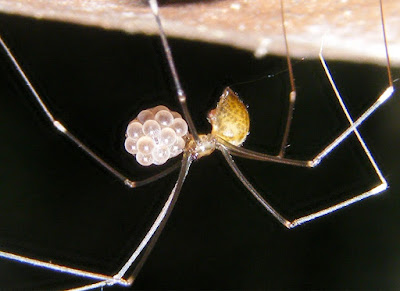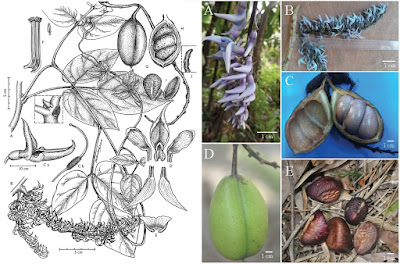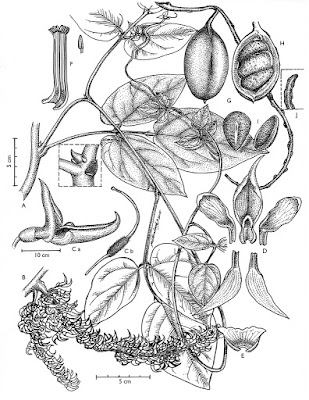[Most Recent Entries] [Calendar View]
Thursday, October 20th, 2016
| Time | Event | ||
| 2:23p | [Arachnida • 2016] Spider Diversity and Endemism in A South American Hotspot: 20 New Species of Carapoia (Araneae: Pholcidae) from Brazil’s Atlantic Forest
Abstract The Atlantic Forest along the eastern South American coast is widely recognized as a hotspot with extreme levels of diversity, endemism, and threat. A megatransect study (2003–2015) focusing on pholcid spiders and covering 48 localities across a large part of the Brazilian Atlantic Forest resulted in 132 morphospecies, of which 81% were new to science. The present paper deals with the species of Carapoia González-Sponga, 1998 collected during this campaign. The endemism level is 100%, i.e. all 26 species of Carapoia in the Atlantic Forest are not known from (and not likely to occur) anywhere else. While few species (all of them with non-overlapping ranges) occur in the most southern and northern regions, the central region (between Rio Doce and Rio Paraguaçu; largely equivalent to what has been called the ‘Bahia refuge’) is characterized by high diversity and up to five species per locality. The following species are newly described (from South to North): Carapoia voltavelha (Santa Catarina); C. macacu, C. divisa (Rio de Janeiro); C. nairae, C. capixaba, C. mirim, C. patafina (Espírito Santo); C. pau, C. gracilis, C. zumbii, C. dandarae, C. marceloi, C. viridis, C. jiboia, C. carvalhoi, C. carybei (Bahia); C. alagoas (Alagoas); C. saltinho, C. abdita (Pernambuco); C. septentrionalis (Pernambuco to Rio Grande do Norte). New records and amendments are given for most previously described Atlantic Forest species. Keywords: Araneae, Atlantic Forest, Brazil, Carapoia, taxonomy, distribution ranges, endemism Bernhard A. Huber. 2016. Spider Diversity and Endemism in A South American Hotspot: 20 New Species of Carapoia (Araneae: Pholcidae) from Brazil’s Atlantic Forest. Zootaxa. 4177(1); 1-69. DOI: 10.11646/zootaxa.4177.1.1 | ||
| 3:31p | [Botany • 2016] Strongylodon juangonzalezii • A Remarkable New Species of Strongylodon (Fabaceae) from Mulanay, Quezon Province, Philippines
Abstract A new species, Strongylodon juangonzalezii Hadsall, Alejado & Cajano, collected from Buenavista Protected Landscape, Mulanay, Quezon, is hereby described. The new species is remarkable for its plagiotropic dense inflorescence made up of 27–31 flowers per cluster in a lateral branch. Flowers are lilac when young, then gradually turn blue when mature. A comparison of the morphology of S. juangonzalezii and related species of Strongylodon in the Philippines is provided. Detailed illustration based on the holotype and photos from its natural habitat are also included. With this new species, the Philippines now harbors eight endemic species of Strongylodon. A key to distinguish the species is provided. Keywords: Mulanay, Fabaceae, Quezon, Philippines, Strongylodon Diagnosis: Strongylodon juangonzalezii a habens inflorescentiae racemi spicae densi plagiotropici, lilacinus cum iuvenibus et caerulei cum maturibus, et cum brachyblastae cylindricae et magis quam tres flores in congeners differt. Strongylodon juangonzalezii differs from other species of Strongylodon in having dense plagiotropic raceme inflorescence with flowers that are lilac when young and turn blue when mature, and with brachyblasts that are cylindrical and more than 3 flowered. Etymology: This new species is named after Dr. Juan Carlos Tecson Gonzalez, current director UPLB-MNH, professor of zoology, one of the Philippines ten outstanding young scientists in 2011, a passionate conservationist and ornithologist. Distribution: So far only two thriving lianas of this species are known from Buenavista Protected Landscape, Mulanay, Quezon Province where it was collected. Habitat and ecology: This liana thrives in a disturbed secondary growth forest climbing atop a large tree at an altitude of 295 m. The area is adjacent to an old coconut plantation. Phenology: Flowering and fruiting from February to mid-March. Annalee S. Hadsall, Michelle D.R. Alejado, Ariel R. Larona and Ivy Amor F. Lambio. 2016. Strongylodon juangonzalezii, A Remarkable New Species of Strongylodon (Fabaceae) from Mulanay, Quezon Province, Philippines. PhytoKeys. 73: 1-12. DOI: 10.3897/phytokeys.73.10055 |
| << Previous Day |
2016/10/20 [Calendar] |
Next Day >> |




